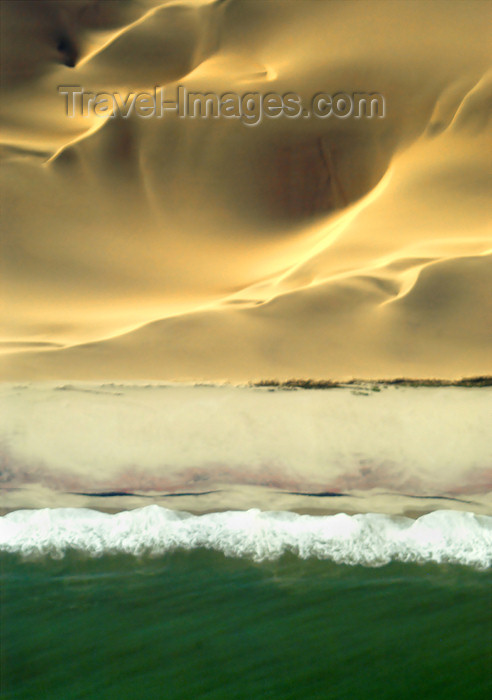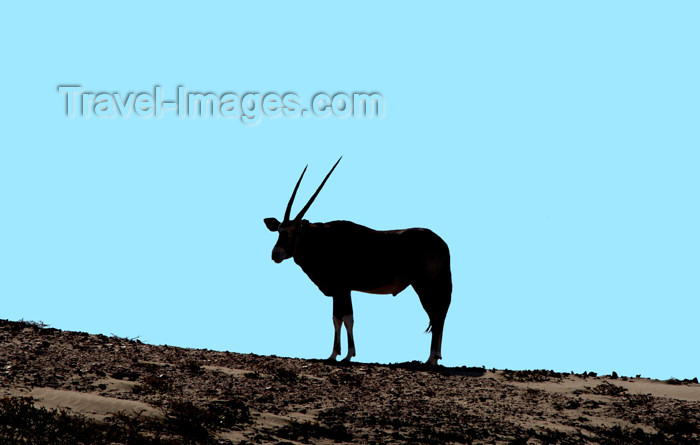| Travel
Articles for Publishers |
Travel-Images.com
|
|
|
The travel article
below is available for publishing, with or without photos (more
images available). Please contact us
with details about your publication for a detailed quote. Both this article
and all the images are copyrighted. Other travel
articles are also available for publishing.
Namibia: Haunting Beauty
of the Skeleton Coast
by Bill Cain
 At
4:00 in the afternoon we had our third flat tire of the day. Insofar as
our Land Rover was equipped with only two spares, Eric our guide radioed
back to the lodge to have a second vehicle dispatched for the rescue of
our 5-person group. Fortunately, we were just 45 minutes from camp. This,
as it turned out, was only the last of four vehicular mishaps that day
– the first having involved a failure of the four wheel drive mechanism
that necessitated a 2-hour round trip retrace back and forth to camp. Such
is life on the rugged Skeleton Coast of north western Namibia where, on
a typical day of sightseeing, a flat tire is the norm rather than the exception.
At
4:00 in the afternoon we had our third flat tire of the day. Insofar as
our Land Rover was equipped with only two spares, Eric our guide radioed
back to the lodge to have a second vehicle dispatched for the rescue of
our 5-person group. Fortunately, we were just 45 minutes from camp. This,
as it turned out, was only the last of four vehicular mishaps that day
– the first having involved a failure of the four wheel drive mechanism
that necessitated a 2-hour round trip retrace back and forth to camp. Such
is life on the rugged Skeleton Coast of north western Namibia where, on
a typical day of sightseeing, a flat tire is the norm rather than the exception.
Unless you’re delivering supplies, one
can’t drive to the Skeleton Coast Camp. Small six seater bush planes shuttle
guests only on Saturdays and Wednesdays back and forth from Swokopmund,
the nearest town some two flying hours to the south. With only six huts
and a main lodge, it’s the smallest of the twelve camps managed by Wilderness
Adventures in Namibia and the three or four day experience is intimately
shared between guests and staff. It’s also the only camp located within
the boundaries of one of the many national parks of Namibia - the only
country in the world to have written environment protection laws into its
constitution.
Unlike the other Wilderness camps which
typically involve an early morning drive and a second one late in the afternoon,
sandwiched around mid day down time at the camp, all day excursions into
the park’s kaleidoscope landscapes are the Skeleton Coast Camp’s specialty.
Breathtaking, surreal, lunar-like and just plain beautiful are a few ways
to describe the environs here. Within a few hours a drive can encompass
flat pan desert that stretches to the horizon, partially dried up river
beds with vegetation that sustains wildlife, swirling sand dunes with wind
swept formations and rugged granite mountain ranges. Shapes and colors
continually change from red feldspar, to green verdite, to whitish silica
and to black basalt. Creamy yellow and orange sand dunes are swirled everywhere
and everything is framed under a constant pale blue sky that showed not
even a hint of a cloud until we approached the ocean.
The Skeleton Coast derives its name from
the over 500 ship wrecks which have met their fate over the centuries along
its 450 miles of coastline. Many of these wrecks still litter the desolate
beaches and coins as well as other small artifacts continue to wash ashore.
The reason the area is so accident prone is due to the near constant fog,
wind and foul weather which plagues the entire coast from Swokopmund to
the Angolan border. Perhaps the most infamous of these wrecks is that of
the British passenger liner the Dunedin Star, which sunk in 1942 and precipitated
one of the greatest sea sagas of all time. In a harrowing series of rescue
attempts, another boat, as well as a small plane also met their doom with
additional loss of life. The remains of the plane are close to the camp
and is usually included in one of the all day drives. The entire story
can be read as a short Internet book, “Skeleton Coast” by John Marsh at
www.rapidttp.co.za/skeleton.
Roads on the skeleton coast are wherever
you want them to be and parallel tire tracks criss-cross through the rough
terrain, taking the paths of least resistance. The Land Rovers do, however,
have the ability to scramble over many of the dunes and rock formations,
affording impressive vistas of this bleak but hauntingly beautiful region.
One unusual destination, known as the “roaring sand dunes”, is always included
the three or four day itinerary. The roar is artificially produced by sliding
down one of the designated dunes and can be aptly described as high decibel
flatulence. With a group of people sliding simultaneously side by side,
the effect is nothing short of hilarious. The unique, spherical shape of
the grains of sand in just this one area, from what I was told, allows
for this audio anomaly.
While not considered a wildlife destination
like many of the other Namibian Wilderness camps, horned oryx, the national
symbol of Namibia are plentiful, as are the deer-like springbok. Desert
elephants and giraffes are usually seen and the lucky few will also stumble
upon an occasional lion, hyena and jackal.
 Though
far removed from civilization, the Skeleton Coast is not without the opportunity
for an exotic cultural exchange, as it’s home to the nomadic Himba people,
some of whom have semi-permanent settlements within driving distance of
the camp. A visit to these friendly and accommodating people always includes
a mandatory demonstration of the women’s bizarre custom of covering every
square inch of their bodies with layer upon layer of ochre mud. The orangey-colored
powder is painstakingly ground from rocks, mixed with water and butter
fat and then smeared over the face, hair and the rest of the anatomy in
a daily ritual of self adornment. Some Himba live their entire lives from
infancy, perpetually covered with ochre, rarely, if ever, seeing their
natural skin.
Though
far removed from civilization, the Skeleton Coast is not without the opportunity
for an exotic cultural exchange, as it’s home to the nomadic Himba people,
some of whom have semi-permanent settlements within driving distance of
the camp. A visit to these friendly and accommodating people always includes
a mandatory demonstration of the women’s bizarre custom of covering every
square inch of their bodies with layer upon layer of ochre mud. The orangey-colored
powder is painstakingly ground from rocks, mixed with water and butter
fat and then smeared over the face, hair and the rest of the anatomy in
a daily ritual of self adornment. Some Himba live their entire lives from
infancy, perpetually covered with ochre, rarely, if ever, seeing their
natural skin.
With our flat tire rescue assured, we reached
camp safely before sunset that evening. It being the farewell evening,
our tourist party was treated to an open air barbecue followed by local
Namibian entertainment unabashedly performed by the Skeleton Coast Camp
staff. As we were preparing to leave the next morning, word had it that
a delayed supply truck was expected imminently with great anticipation.
I only hoped it contained enough tires to get Eric through until the next
monthly supply truck arrived.
| Travel Articles |
www.travel-images.com
|
 At
4:00 in the afternoon we had our third flat tire of the day. Insofar as
our Land Rover was equipped with only two spares, Eric our guide radioed
back to the lodge to have a second vehicle dispatched for the rescue of
our 5-person group. Fortunately, we were just 45 minutes from camp. This,
as it turned out, was only the last of four vehicular mishaps that day
– the first having involved a failure of the four wheel drive mechanism
that necessitated a 2-hour round trip retrace back and forth to camp. Such
is life on the rugged Skeleton Coast of north western Namibia where, on
a typical day of sightseeing, a flat tire is the norm rather than the exception.
At
4:00 in the afternoon we had our third flat tire of the day. Insofar as
our Land Rover was equipped with only two spares, Eric our guide radioed
back to the lodge to have a second vehicle dispatched for the rescue of
our 5-person group. Fortunately, we were just 45 minutes from camp. This,
as it turned out, was only the last of four vehicular mishaps that day
– the first having involved a failure of the four wheel drive mechanism
that necessitated a 2-hour round trip retrace back and forth to camp. Such
is life on the rugged Skeleton Coast of north western Namibia where, on
a typical day of sightseeing, a flat tire is the norm rather than the exception.
 Though
far removed from civilization, the Skeleton Coast is not without the opportunity
for an exotic cultural exchange, as it’s home to the nomadic Himba people,
some of whom have semi-permanent settlements within driving distance of
the camp. A visit to these friendly and accommodating people always includes
a mandatory demonstration of the women’s bizarre custom of covering every
square inch of their bodies with layer upon layer of ochre mud. The orangey-colored
powder is painstakingly ground from rocks, mixed with water and butter
fat and then smeared over the face, hair and the rest of the anatomy in
a daily ritual of self adornment. Some Himba live their entire lives from
infancy, perpetually covered with ochre, rarely, if ever, seeing their
natural skin.
Though
far removed from civilization, the Skeleton Coast is not without the opportunity
for an exotic cultural exchange, as it’s home to the nomadic Himba people,
some of whom have semi-permanent settlements within driving distance of
the camp. A visit to these friendly and accommodating people always includes
a mandatory demonstration of the women’s bizarre custom of covering every
square inch of their bodies with layer upon layer of ochre mud. The orangey-colored
powder is painstakingly ground from rocks, mixed with water and butter
fat and then smeared over the face, hair and the rest of the anatomy in
a daily ritual of self adornment. Some Himba live their entire lives from
infancy, perpetually covered with ochre, rarely, if ever, seeing their
natural skin.